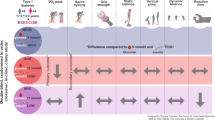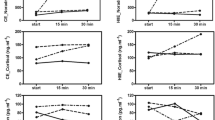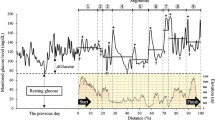Abstract
Purpose
In healthy individuals, high carbohydrate intake is recommended during prolonged exercise for maximum performance. In type 1 diabetes (T1D), this would alter the insulin requirements. The aim of the study was to evaluate the safety of high glucose supplementation during prolonged exercise and the glucose control when a novel strategy of increased carbohydrate supply was implemented during prolonged exercise in T1D.
Methods
Eight subjects with T1D participated in a sports camp including sessions of prolonged exercise and individualized feedback during three consecutive days. This was later followed by a 90 km cross-country skiing race. Large amounts of carbohydrates, 75 g/h, were supplied during exercise and the insulin requirements were registered. Glucose was measured before, during and after exercise aiming at euglycaemia, 4–8 mmol/L (72–144 mg/dL). During the race, continuous glucose monitoring (CGM) was used as an aspect of safety and to allow direct and individual adjustments.
Results
Compared to ordinary carbohydrate supply during exercise, the high carbohydrate supplementation resulted in significantly increased insulin doses to maintain euglycaemia. During the cross-country skiing race, the participants succeeded to reach mean target glucose levels; 6.5 ± 1.9 mmol/L (117 ± 34 mg/dL) and 5.7 ± 1.5 mmol/L (103 ± 27 mg/dL) at the start and finish of the race, respectively. Episodes of documented hypoglycemia (<4 mmol/L/72 mg/dL) were rare. CGM was used for adjustments.
Conclusion
In this study, large carbohydrate supplementation in T1D individuals during prolonged aerobic exercise is safe and allows the subjects to maintain glycaemic control and indicates the feasibility of CGM under these conditions.



Similar content being viewed by others
Abbreviations
- CGM:
-
Continuous glucose monitoring
- CSII:
-
Continuous subcutaneous insulin infusion
- PG:
-
Plasma glucose
- PE:
-
Physical exercise
- T1D:
-
Type 1 diabetes
References
Adolfsson P, Nilsson S, Albertsson-Wikland K, Lindblad B (2012) Hormonal response during physical exercise of different intensities in adolescents with type 1 diabetes and healthy controls. Pediatr Diabetes 13(8):587–596
American Association of Diabetes E (2012) Diabetes and physical activity. Diabetes Educ 38(1):129–132
Battelino T, Phillip M, Bratina N, Nimri R, Oskarsson P, Bolinder J (2011) Effect of continuous glucose monitoring on hypoglycemia in type 1 diabetes. Diabetes Care 34(4):795–800
Black SE, Mitchell E, Freedson PS, Chipkin SR, Braun B (2005) Improved insulin action following short-term exercise training: role of energy and carbohydrate balance. J Appl Phys (Bethesda, MD: 1985) 99(6):2285–2293
Blair SN, Sallis RE, Hutber A, Archer E (2012) Exercise therapy: the public health message. Scand J Med Sci Sports 22(4):e24–e28
Brazeau AS, Mircescu H, Desjardins K, Dube MC, Weisnagel SJ, Lavoie C, Rabasa-Lhoret R (2012) The barriers to physical activity in type 1 diabetes (BAPAD-1) scale: predictive validity and reliability. Diabetes Metab 38(2):164–170
Chokkalingam K, Tsintzas K, Snaar JE, Norton L, Solanky B, Leverton E, Morris P, Mansell P, Macdonald IA (2007) Hyperinsulinaemia during exercise does not suppress hepatic glycogen concentrations in patients with type 1 diabetes: a magnetic resonance spectroscopy study. Diabetologia 50(9):1921–1929
Currell K, Jeukendrup AE (2008) Superior endurance performance with ingestion of multiple transportable carbohydrates. Med Sci Sports Exerc 40(2):275–281
Felig P, Cherif A, Minagawa A, Wahren J (1982) Hypoglycemia during prolonged exercise in normal men. N Engl J Med 306(15):895–900
Hållmarker U (2014) Personal communication. Report regarding the Vasalopp: participants with diabetes. Mora
Holtz KA, Stephens BR, Sharoff CG, Chipkin SR, Braun B (2008) The effect of carbohydrate availability following exercise on whole-body insulin action. Appl Physiol Nutr Metab 33(5):946–956
Iscoe KE, Riddell MC (2011) Continuous moderate-intensity exercise with or without intermittent high-intensity work: effects on acute and late glycaemia in athletes with Type 1 diabetes mellitus. Diabet Med 28(7):824–832
Jeukendrup AE (2010) Carbohydrate and exercise performance: the role of multiple transportable carbohydrates. Curr Opin Clin Nutr Metab Care 13(4):452–457
McMahon SK, Ferreira LD, Ratnam N, Davey RJ, Youngs LM, Davis EA, Fournier PA, Jones TW (2007) Glucose requirements to maintain euglycemia after moderate-intensity afternoon exercise in adolescents with type 1 diabetes are increased in a biphasic manner. J Clin Endocrinol Metab 92(3):963–968
Rabasa-Lhoret R, Bourque J, Ducros F, Chiasson JL (2001) Guidelines for premeal insulin dose reduction for postprandial exercise of different intensities and durations in type 1 diabetic subjects treated intensively with a basal-bolus insulin regimen (ultralente-lispro). Diabetes Care 24(4):625–630
Riddell MC, Milliken J (2011) Preventing exercise-induced hypoglycemia in type 1 diabetes using real-time continuous glucose monitoring and a new carbohydrate intake algorithm: an observational field study. Diabetes Technol Ther 13(8):819–825
Riddell MC, Perkins BA (2006) Type 1 diabetes and vigorous exercise: applications of exercise physiology to patient management. Can J Diabetes 30(1):63–71
Sane T, Helve E, Pelkonen R, Koivisto VA (1988) The adjustment of diet and insulin dose during long-term endurance exercise in type 1 (insulin-dependent) diabetic men. Diabetologia 31(1):35–40
Schonfelder M, Hinterseher G, Peter P, Spitzenpfeil P (2011) Scientific comparison of different online heart rate monitoring systems. Int J Telemed Appl 2011. Article ID: 631848
Temple MY, Bar-Or O, Riddell MC (1995) The reliability and repeatability of the blood glucose response to prolonged exercise in adolescent boys with IDDM. Diabetes Care 18(3):326–332
Wiesli P, Schmid C, Kerwer O, Nigg-Koch C, Klaghofer R, Seifert B, Spinas GA, Schwegler K (2005) Acute psychological stress affects glucose concetrations in patients with type 1 diabetes following food intake but not in the fasting state. Diabetes Care 28(8):1910–1915
Yardley JE, Iscoe KE, Sigal RJ, Kenny GP, Perkins BA, Riddell MC (2013) Insulin pump therapy is associated with less post-exercise hyperglycemia than multiple daily injections: an observational study of physically active type 1 diabetes patients. Diabetes Technol Ther 15(1):84–88
Yardley JE, Zaharieva DP, Jarvis C, Riddell MC (2015) The “Ups” and “Downs” of a bike race in people with type 1 diabetes: dramatic differences in strategies and blood glucose responses in the Paris-to-Ancaster spring classic. Can J Diabetes 39(2):105–110
Acknowledgments
This work was supported by unrestricted Grants from Novo Nordisk Scandinavia.
Author information
Authors and Affiliations
Corresponding author
Ethics declarations
Conflict of interest
Peter Adolfsson is one of the founders and a board member of Diasend.
Additional information
Communicated by Michael Lindinger.
Rights and permissions
About this article
Cite this article
Adolfsson, P., Mattsson, S. & Jendle, J. Evaluation of glucose control when a new strategy of increased carbohydrate supply is implemented during prolonged physical exercise in type 1 diabetes. Eur J Appl Physiol 115, 2599–2607 (2015). https://doi.org/10.1007/s00421-015-3251-4
Received:
Accepted:
Published:
Issue Date:
DOI: https://doi.org/10.1007/s00421-015-3251-4




